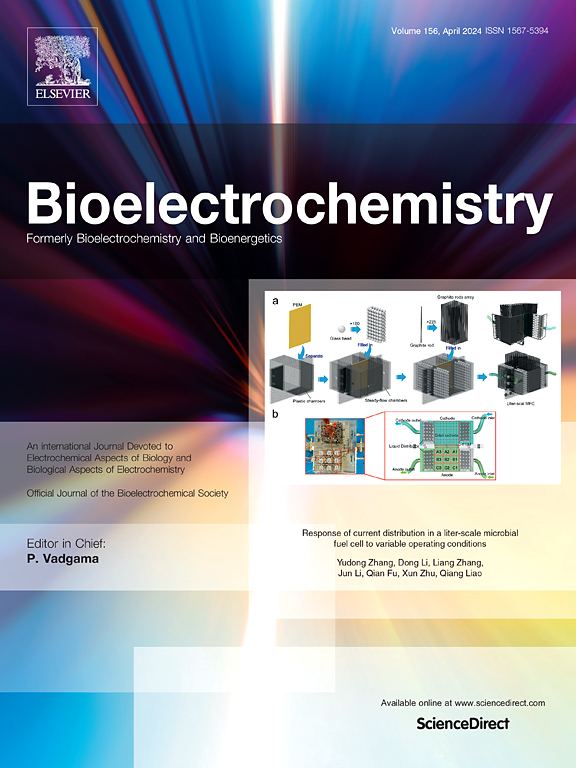基于铜纳米簇的级联扩增DNA电化学检测结合生物条形码分析和表面引发酶聚合
IF 4.8
2区 化学
Q1 BIOCHEMISTRY & MOLECULAR BIOLOGY
引用次数: 0
摘要
癌症的早期诊断对于提高治疗效果、延长患者生存期和改善生活质量至关重要。我们开发了一种高灵敏度的电化学生物传感器,用于检测与胃癌相关的靶DNA (tDNA)。这一进展整合了双信号扩增策略:生物条形码扩增(BCA)和表面启动酶聚合(SIEP),铜纳米团簇(CuNCs)作为信号标签。将二氧化硅纳米颗粒(SiO2)与聚胸腺胺(poly T)和互补DNA共价连接,制备生物条形码探针。通过杂交,这些探针被固定在还原氧化石墨烯和Au纳米颗粒(rGO-AuNPs)修饰的界面上,并标记了电信号的第一次放大。随后,SIEP引发的扩展多聚T通过T- cu2 +结合结合额外的cunc,导致第二轮信号放大。在1 fmol/L到1 nmol/L的线性响应范围内,该传感器的最小检测限为0.13 fmol/L。它还显示出良好的特异性、可重复性和稳定性,使其成为敏感检测胃癌生物标志物的有前途的工具。本文章由计算机程序翻译,如有差异,请以英文原文为准。
Copper nanocluster based cascade amplified DNA electrochemical detection combining with bio-barcode assay and surface-initiated enzyme polymerization
Early cancer diagnosis is paramount for enhancing treatment efficacy, extending patient survival, and improving the quality of life. We developed a highly sensitive electrochemical biosensor for the detection of target DNA (tDNA) associated with gastric cancer. This advancement integrates dual signal amplification strategies: bio-barcode amplification (BCA) and surface-initiated enzyme polymerization (SIEP), with copper nanoclusters (CuNCs) serving as signal labels. Silica nanoparticles (SiO2) were covalently linked with polythymine (poly T) and complementary DNA to create bio-barcode probes. These probes, through hybridization, were immobilized on the reduced graphene oxide and Au nanoparticle (rGO-AuNPs) modified interface and marking the first amplification of the electrical signal. Subsequently, the extended poly T prompted by SIEP bound additional CuNCs through the combination of T-Cu2+, leading to a second round of signal amplification. The biosensor demonstrated a minimum detection limit of 0.13 fmol/L over a linear response range from 1 fmol/L to 1 nmol/L. It also showcased excellent specificity, repeatability, and stability, making it a promising tool for the sensitive detection of gastric cancer biomarkers.
求助全文
通过发布文献求助,成功后即可免费获取论文全文。
去求助
来源期刊

Bioelectrochemistry
生物-电化学
CiteScore
9.10
自引率
6.00%
发文量
238
审稿时长
38 days
期刊介绍:
An International Journal Devoted to Electrochemical Aspects of Biology and Biological Aspects of Electrochemistry
Bioelectrochemistry is an international journal devoted to electrochemical principles in biology and biological aspects of electrochemistry. It publishes experimental and theoretical papers dealing with the electrochemical aspects of:
• Electrified interfaces (electric double layers, adsorption, electron transfer, protein electrochemistry, basic principles of biosensors, biosensor interfaces and bio-nanosensor design and construction.
• Electric and magnetic field effects (field-dependent processes, field interactions with molecules, intramolecular field effects, sensory systems for electric and magnetic fields, molecular and cellular mechanisms)
• Bioenergetics and signal transduction (energy conversion, photosynthetic and visual membranes)
• Biomembranes and model membranes (thermodynamics and mechanics, membrane transport, electroporation, fusion and insertion)
• Electrochemical applications in medicine and biotechnology (drug delivery and gene transfer to cells and tissues, iontophoresis, skin electroporation, injury and repair).
• Organization and use of arrays in-vitro and in-vivo, including as part of feedback control.
• Electrochemical interrogation of biofilms as generated by microorganisms and tissue reaction associated with medical implants.
 求助内容:
求助内容: 应助结果提醒方式:
应助结果提醒方式:


